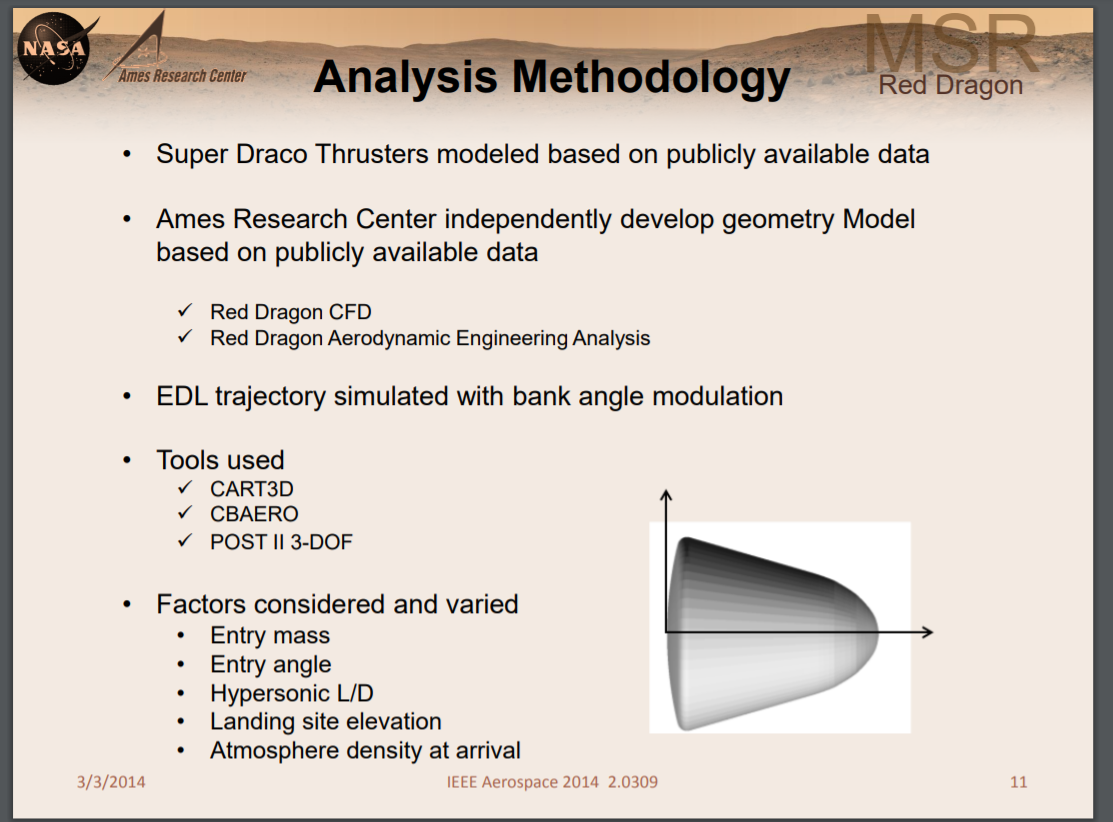I'm looking for some estimates of Dragon's ballistic or drag coefficients in its reentry (heat shield forward) configuration. Estimates for other spacecraft would be useful also as they would give me some intuition of what's normal and what's not. I know the exact numbers depend on many factors like air density, velocity, etc, but it's OK if you know them for just some (any) particular configuration. Ballpark figures OK. Thanks!
2 Answers
This may be of help to you: Planetary Mission Entry Vehicles Quick Reference Guide. Version 3.0. It contains lots of data on various entry probes (including ballistic coefficients) although it only goes up until 2003 (MER-A & MER-B).
Edit:
User has retired but question is still likely to be of interest, and I have found an accurate estimate while working on an answer to Dragon re-entry flight profile?
While in general a function of Mach number, these values are (pretty much) invariant in the hypersonic regime (Mach >= 5) and can reasonably be treated as constants in low-mid fidelity simulations.
I was able to infer a drag coefficient from the abstract of A. A. Gonzales et al., "Mars Sample Return using commercial capabilities: Mission architecture overview" and its associated presentation focusing on EDL.
The presentation contains this slide on methodology showing that NASA Ames did some CFD on a representative Dragon 2 / Crew Dragon model:
From abstract:
Total entry masses between 7 and 10 mt were considered
Plot from presentation:
Where $\beta$ is the ballistic coefficient $\beta=\frac{m}{C_D S}$:
| Area, S ($m^2$) | Mass (kg) | $\beta$ ($kg/m^2$) | $C_D$ |
|---|---|---|---|
| 12.6 | 7,000 | 450 | 1.24 |
| 12.6 | 10,000 | 650 | 1.22 |
Thus $C_D=1.23$ (and $\beta=622$ $kg/m^2$).
References:
- A. A. Gonzales et al., "Mars Sample Return using commercial capabilities: Mission architecture overview," 2014 IEEE Aerospace Conference, 2014, pp. 1-15, doi: 10.1109/AERO.2014.6836421.
- L. G. Lemke et al."Mars Sample Return Using Commercial Capabilities: Propulsive Entry, Descent and Landing," 2014 IEEE Aerospace Conference, 2014 (retrieved from NTRS id: 20140013203)
-
1$\begingroup$ Thanks, Brendan! This helps! $\endgroup$– user39728Commented May 3, 2021 at 17:55
Not knowing how much you already know about this, I'll just point out that drag coefficients at high speeds (10-25 Ma) are still Mach number dependent, though far less so than at low Mach number (less than 3 Ma). They are also dependent on air density and pressure (Reynolds effect). Most modeling takes a simplified approach and ignores much of this. Suggest looking at John Anderson's book on introduction to flight or fundamental aerodynamics to see some graphs of coefficient of drag vs Mach that make this point. The topic you ask about is referred to as "blunt body" aerodynamics.
-
$\begingroup$ Thanks, Chris! This is helpful! I'll take a look at Anderson's. Navigation, guidance, control... by themselves they're already so taxing... but once you figure them out, then you're good to go... but sadly, aerodynamics... take a lot of empirical data that is just very hard to find... and nevermind the physics that can seem so elusive just when you thought you had it figured out... Can you say more about how simplified modeling normally is---would you approximate your drag coefficients as constants, say, even though you're covering subsonic through hypersonic regimes? Constants are nice. $\endgroup$– user39728Commented May 4, 2021 at 4:58
-
$\begingroup$ Check NASA's Technical Report Server (NTRS) for "blunt body aerodynamics". You might find a CD vs Ma curve that can help. Anderson's book on Fundamentals of Aerodynamics has some good materials. $\endgroup$ Commented May 4, 2021 at 19:47
-
$\begingroup$ Thanks! Any good references for cD vs Ma (and maybe even also angle of attack) in ogive rockets similar in shape/size to Falcon 9 (230 ft length, 12 ft dia) and stretching from subsonic through hypersonic regimes? I'm conceding I won't find just the right data, so I'm looking for the best approximation out there... $\endgroup$– user39728Commented May 4, 2021 at 19:53
-
$\begingroup$ In my limited experience in this, I've never seen two different CFD models produce the same CD vs Mach curve. This is a gap in the community that I didn't realize existed until a few years ago. First stage flight for F9 is all you really need worry about; second stage starts in near vacuum (>100 kft). Long slender body approximation should work for you given F9's aspect ratio (230:12) even though nose is not sharp on F9. Won't be perfect but quite close for low to medium fidelity trajectory estimates. High fidelity is a different ball game but you are probably not trying for that, I think. $\endgroup$ Commented May 5, 2021 at 13:25

